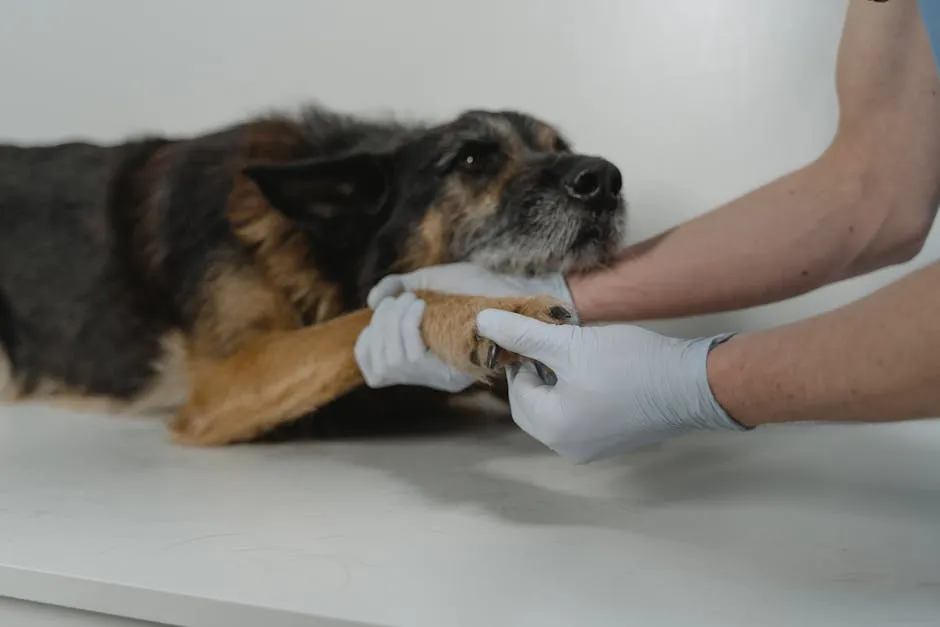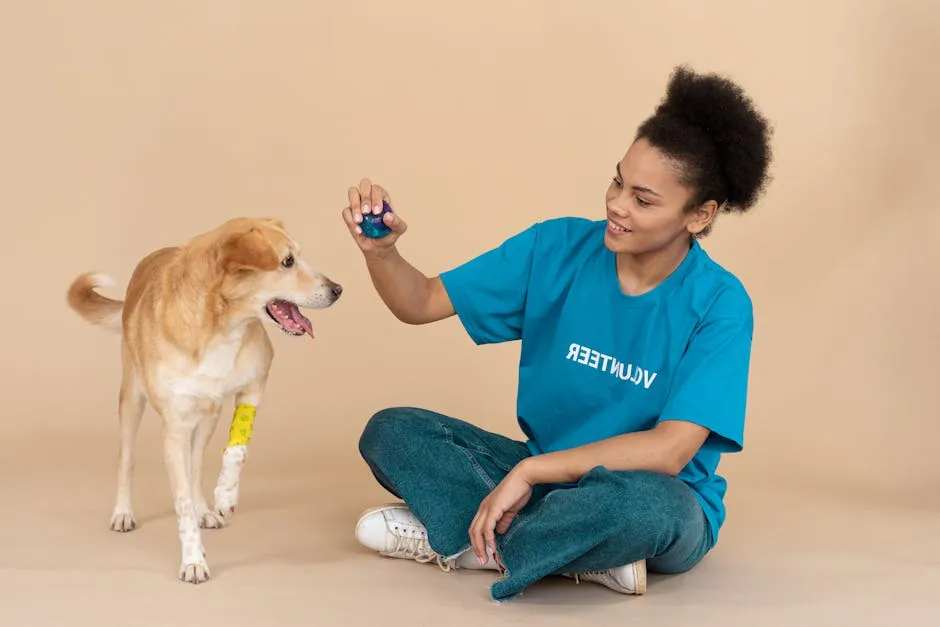Introduction
Have you ever seen a dog bring smiles in hospitals or schools? Therapy dogs play a vital role in providing comfort and support to individuals in various settings. Their gentle nature helps people cope with stress, anxiety, and loneliness.
Certifying your therapy dog benefits both you and your furry friend. It ensures they are well-trained and ready to help others. In this article, we’ll give you a complete overview of therapy dog certification and its importance.
To ensure your furry companion is clean and dapper, consider using a Dog Grooming Kit. This kit will keep your dog looking their best, making them a prime candidate for therapy work.

Summary and Overview
So, what exactly are therapy dogs? These are pets that provide comfort and affection in therapeutic settings. They differ from service dogs, which assist individuals with disabilities. Therapy dogs are trained to interact with many people, bringing joy wherever they go.
Therapy dogs are beneficial in places like hospitals, schools, and nursing homes. They help reduce anxiety, promote healing, and improve overall well-being. You might wonder how to get your dog certified. The process typically involves training, temperament assessment, and successful testing.
Many organizations, such as the AKC, Therapy Dogs International (TDI), and Companion Paws, offer certification. In this article, we will cover the requirements, training, and resources available for therapy dog certification.
For those looking to enhance their dog’s training experience, investing in a Dog Training Clicker can be a game changer. This tool helps reinforce positive behaviors, making training sessions more effective and enjoyable for both you and your pup.

What is a Therapy Dog?
A therapy dog is a pet that provides comfort to people in need. They accompany their owners to various settings like hospitals, schools, and nursing homes. Therapy dogs aim to enhance the emotional and psychological well-being of those they visit.
Key characteristics of a good therapy dog include being friendly, calm, and social. They should enjoy human interaction and remain relaxed in busy environments. Therapy dogs are different from service dogs, which are specially trained to assist individuals with disabilities. Emotional support animals also differ, as they primarily provide comfort to their owners.
In the United States, there are approximately 60,000 therapy dogs. These furry companions make a significant impact on the lives of many people.
Do you think your dog has the right temperament for this role? Consider their behavior around strangers and in new environments.
If you’re worried about your dog getting anxious in public spaces, you might want to try Pet Anxiety Relief Chews. These tasty treats can help keep your dog calm and collected during therapy visits, allowing them to focus on their comforting duties.

The Benefits of Therapy Dogs
Therapy dogs offer incredible emotional and psychological support. They can help reduce anxiety and improve mental health. Studies show that these dogs are effective in various settings, providing comfort to individuals facing challenges.
Research indicates that interacting with therapy dogs can lower stress levels. A study published in the Journal of Mental Health found a significant decrease in anxiety among patients when therapy dogs were present. Another study showed that therapy dogs can enhance recovery rates in hospitals, promoting healing and emotional well-being.
Physical health benefits also arise from therapy dog interactions. They encourage physical activity and social engagement, leading to improved overall health. In community settings, therapy dogs foster connections among people, creating a supportive environment.
Communities that embrace therapy dogs often see increased engagement and positivity. These furry friends bring joy and comfort to schools, nursing homes, and hospitals. Their presence can uplift spirits and create a sense of belonging.
Want to learn more about the benefits of therapy dogs? Check out these studies and resources that dive deeper into their impact on mental health and community wellbeing.
Exploring how therapy dogs contribute to mental health can provide valuable insights into their role in communities.
If your dog loves to play and engage, consider adding some Dog Puzzle Toys to their routine. These toys not only keep them entertained but also mentally stimulate them, which is essential for a well-rounded therapy dog.

Steps to Certify Your Dog as a Therapy Dog
Certifying your dog as a therapy dog involves several important steps. First, it’s crucial to understand the training programs available. Many organizations require dogs to complete the Canine Good Citizen program before certification. This program ensures your dog is well-behaved and socialized.
Next, health documentation is essential. Your dog must be up to date on vaccinations and have a clean bill of health from a veterinarian. This protects both your dog and the individuals they will visit.
Once your dog has completed training, they’ll undergo a temperament assessment. This evaluation checks for your dog’s calmness and friendliness. It’s vital for therapy work. After passing this assessment, you’ll need to schedule a final evaluation.
During the final evaluation, your dog will be tested in various scenarios. Evaluators assess your dog’s ability to handle different environments and interactions. Only those who pass will receive certification.
Each year, thousands of therapy dog teams are certified across the country. Joining this community can be rewarding and fulfilling. Looking for training resources? Check out organizations like the AKC and Therapy Dogs International for guidance.
To keep your dog comfortable during travel to certifications, consider investing in a Dog Carrier Backpack. This convenient option allows you to transport your dog easily while keeping them secure and comfortable.
1. Training Your Dog
Training is the foundation for a successful therapy dog. Basic obedience is crucial, along with socialization. Your dog should learn commands like sit, stay, and come. These commands ensure your dog behaves well in public settings.
Several training programs are available for aspiring therapy dogs. The AKC Canine Good Citizen program is highly recommended. It covers essential skills and prepares your dog for therapy work. Another great option is Pet Partners, which offers specialized training for therapy dogs.
Socialization is just as important as obedience training. Your dog should feel comfortable around new people and environments. Regular exposure to different situations will help your dog thrive in therapy roles.
Ready to get started? Look for local training classes or workshops. Many organizations offer excellent resources. Get your dog on the path to becoming a certified therapy dog today!

2. Health Requirements
To certify your dog as a therapy dog, health documentation is crucial. First, your dog must have current vaccinations. Common vaccinations include rabies, distemper, and parvovirus. These shots protect your dog and the people they will visit. Ensure your dog receives annual vaccinations to stay compliant.
Regular health checks also play a vital role. A veterinarian should perform a thorough examination before certification. This ensures your dog is healthy and free from contagious diseases. A clean bill of health from the vet is often a requirement for therapy dog programs.
Maintaining your dog’s health is essential for their therapy work. A healthy dog can provide comfort and support more effectively. Plus, it helps prevent any potential health risks to those they interact with.
Consult with your veterinarian for specific health requirements and vaccination schedules. They can guide you on keeping your therapy dog in top condition.

Additionally, consider a Dog First Aid Kit to ensure you’re prepared for any minor mishaps during therapy visits. Being equipped with first aid supplies can provide peace of mind while you’re out and about with your therapy dog.
3. Evaluation Process
The evaluation process for therapy dog certification is comprehensive. It typically includes several key testing steps to assess your dog’s temperament and behavior. Evaluators look for calmness, sociability, and obedience during interactions with people.
The first part is a check-in, where the evaluator assesses your dog’s overall demeanor. They ensure your dog is well-groomed and friendly. Next, the testing includes walking through a crowd. Your dog should handle distractions without becoming anxious or aggressive.
Another crucial part of the evaluation is the reaction to various stimuli. This might involve meeting other dogs, children, or loud noises. Your dog should remain calm and composed throughout these scenarios.
Statistics show that around 70% of dogs pass the evaluation on the first attempt. However, common pitfalls include excessive barking or fearfulness during tests. Being well-prepared can help avoid these issues.
Overall, preparation is key to success. Familiarizing your dog with different environments can make a significant difference. Encourage your dog to interact positively with people and other pets.
Ready to get started? Begin preparing your dog for evaluation to ensure a smooth certification process.

Organizations Offering Therapy Dog Certification
When it comes to certifying your therapy dog, several reputable organizations can help. Each has its own requirements and processes, so it’s essential to understand the differences.
The American Kennel Club (AKC) offers a Therapy Dog program that recognizes therapy work. Dogs can earn titles based on the number of visits they complete. For instance, to achieve the AKC Therapy Dog title, your pup must complete 50 visits. This program encourages volunteers to engage with their dogs in various therapeutic settings, such as schools and hospitals.
Therapy Dogs International (TDI) is another prominent organization focused on enhancing well-being through therapy dog programs. Their certification process includes a rigorous evaluation to ensure each dog meets specific temperament and behavior standards. TDI requires dogs to pass a test that checks their ability to remain calm and friendly in various situations. This organization emphasizes the importance of training and socialization for therapy dogs.
Companion Paws offers a unique certification program that assesses dogs for personal, assisted, or visiting therapy roles. They evaluate dogs based on temperament and health, ensuring they can interact positively with people. Their training includes online courses and hands-on assessments, making it accessible for various handlers.
Other organizations like the Alliance of Therapy Dogs and Canine Companions provide additional options for certification. Each organization has its own focus and methodology, so it’s worthwhile to explore which aligns best with your goals.
For more information about the certification processes, visit the official websites of these organizations: AKC Therapy Dog Program, TDI Certification, and Companion Paws.

Can a Certified Therapy Dog Go Anywhere?
Therapy dogs have specific access rights that differ significantly from service dogs. While service dogs assist individuals with disabilities and have broad access rights under the Americans with Disabilities Act (ADA), therapy dogs do not share these privileges. Instead, they may visit designated facilities like hospitals, schools, and libraries that allow therapy dog programs.
In public spaces, therapy dogs are considered pets. This means they typically cannot enter places where pets are not allowed, such as restaurants or stores. Their access is limited to approved locations, making it essential for handlers to understand these regulations.
Handlers of therapy dogs carry the responsibility to ensure their dog’s behavior is appropriate in various settings. They must also be aware of the specific rules of each facility they visit. Some facilities may have additional requirements, such as health certifications or specific training.
To stay informed, it’s always a good idea to check local laws and facility regulations regarding therapy dog access. This ensures both you and your dog can enjoy the experience positively and responsibly.

Conclusion
Therapy dog certification is essential for both dogs and handlers. It ensures that your dog is well-trained and equipped to provide comfort and support. By following the outlined steps, you can take the important leap toward certification.
The benefits of therapy dogs are profound. They enhance emotional well-being and create a positive impact in various environments. Certified therapy dogs can bring joy to hospitals, schools, and more. So, consider this rewarding path for your furry friend!
If you’re looking for a way to keep your dog hydrated during therapy visits, a Dog Water Bottle is a must-have. Keeping your dog hydrated helps them stay calm and focused during their visits.

What are the requirements for therapy dog certification?
Typical requirements include completing basic training programs, undergoing health checks, and passing evaluations. Dogs must demonstrate good manners and a friendly demeanor during assessments.
Can any dog become a therapy dog?
Yes, but temperament matters more than breed. Friendly, calm, and sociable dogs of any breed can qualify as therapy dogs.
How long does it take to train a therapy dog?
Training duration varies, but most dogs need several months to complete training and certification processes. Regular practice and socialization are key.
Are therapy dogs the same as service dogs?
No, they are different. Service dogs assist individuals with disabilities and have specific public access rights. Therapy dogs provide comfort to others but do not have the same access privileges.
What kinds of settings do therapy dogs visit?
Therapy dogs visit a range of environments, including hospitals, schools, nursing homes, and libraries. They are typically invited into places that support therapy dog programs.
Do therapy dogs need to be registered with a specific organization?
Yes, registration with a recognized therapy dog organization is usually required for certification. This ensures adherence to training and behavioral standards.
Can therapy dogs be used in schools?
Absolutely! Therapy dogs can play a vital role in educational settings. They help reduce stress and anxiety in students, fostering a supportive learning environment.
Please let us know what you think about our content by leaving a comment down below!
Thank you for reading till here 🙂
All images from Pexels





